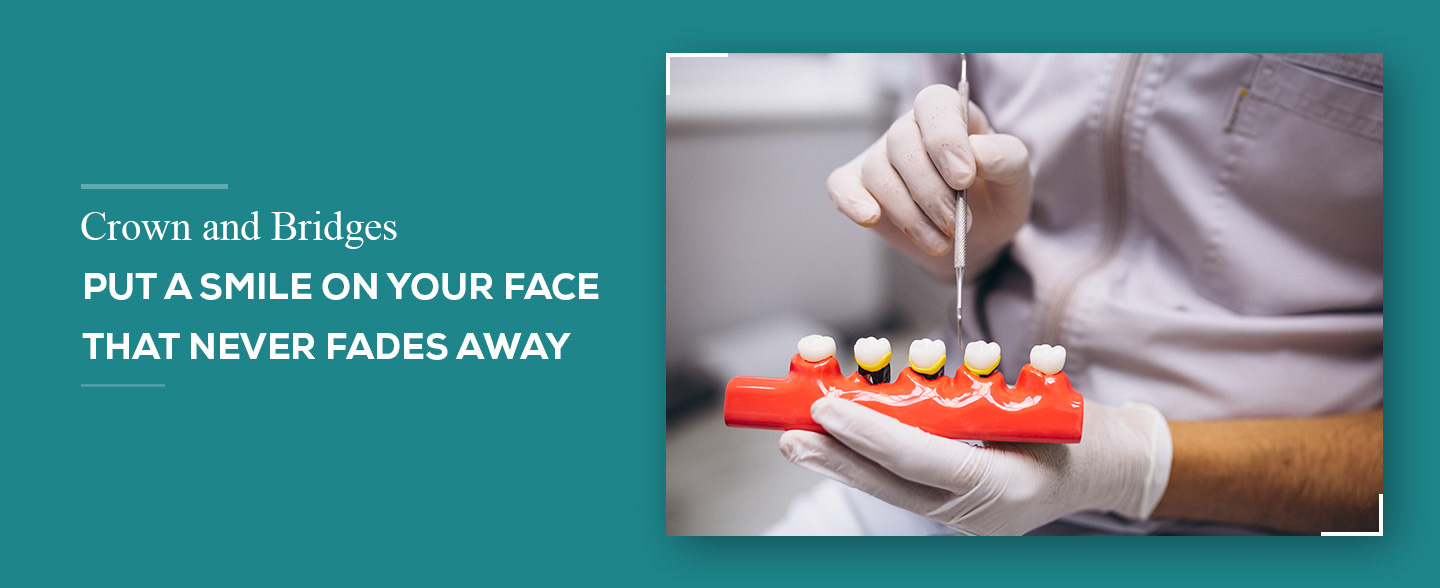
Commonly referred to as a "cap", a crown is a dental restoration that covers the tooth. Crowns strengthen and protect the tooth and are also used to improve the appearance of your teeth.
Crowns can be made from different materials. They include the full porcelain crown, the porcelain fused-to-metal crown and the all-metal crown. The type of crown to be selected depends upon the aesthetic concerns and the strength requirements of the teeth involved.
Fitting a crown requires at least two appointments. During your first visit, a local anesthetic is given after which the tooth is prepared for the crown. The decayed and weakened parts are removed and the tooth is repaired and shaped to receive the crown. Next, an impression or mould is made of the prepared tooth. The impression is sent to the laboratory and an exact model of the drilled tooth is made. The crown is then fabricated on this model.
Meanwhile, to protect the tooth a temporary plastic (acrylic) crown is placed over the prepared tooth. It prevents the drilled tooth from drifting its position and helps in keeping the gum around the tooth healthy.
Do not be afraid to clean your teeth between visits and avoid hard or sticky foods. Sometimes, even with meticulous care, temporary crowns or bridges may come loose. If this should occur, place the temporary crown or bridge back on your tooth immediately. Putting a drop of Vaseline™ or even toothpaste in the temporary crown or bridge will help hold it in place until you can schedule an appointment. Replacing the temporary crown immediately is very important as it only takes a short time for teeth to move. This may even necessitate new impressions resulting in a great deal of wasted time, energy and money.
At this time, the temporary crown is removed and any temporary cement is cleaned from the prepared tooth. The final crown is tried onto the tooth and checked for accuracy in fit and in bite. Any discrepancies are adjusted and the crown is evaluated for aesthetics. If all these factors are acceptable, the crown is cemented permanently to the tooth.
A bridge is a fixed dental replacement for one or more missing teeth. It consists of an artificial tooth that is suspended between two adjacent teeth. This replacement is attached to crowns that are made for the adjacent teeth.
The loss of a single tooth can have a major impact on your personal appearance and dental health. When one or more teeth are missing, the remaining teeth can drift out of position. This can lead to a change in the bite, loss of additional teeth, decay and gum disease. Ultimately, your ability to chew comfortably and your appearance may be affected. In such situations it is advisable to replace the missing teeth.
The steps involved in making a bridge are very similar to those for making a crown. At least two appointments are necessary. At the first visit, your dentist will prepare the teeth next to the missing tooth for crowns. An impression of the prepared teeth will be made and a temporary bridge will be placed. At the subsequent visit, your dentist will fit and adjust the bridge and then cement it in place.
Bridges can be made from the same materials as crowns - full porcelain, porcelain fused-to-metal, and all metal. The choice of material will depend on the aesthetic and functional requirements of the restoration.
Your new bridge will require special care when brushing and flossing. You may need to use various cleaning aids such as crown and bridge floss e.g. Super floss, use of water pik etc. to help you clean around and under the bridge so as to keep the plaque off and prevent further decay and gum disease. Don't worry, Dr. Yadav will explain and demonstrate all these instructions to you at our centre.
There is generally soreness around the gum line. Pressure and temperature sensitivity may be felt for a few days. It is not unusual for the new crown to be mildly sensitive to cold temperatures for a few weeks. This sensitivity should gradually decrease and eventually subside. However, if it is severe and does not subside you should contact your dentist. Occasionally, the bite may feel uncomfortable and may need further adjustments.
While you are numb it is very important to be careful not to bite your lip or tongue until sensation has returned. If your child is the patient, please watch carefully to make sure he/she does not play with their tongue or lip while it is numb.
Anesthesia lasts for about 3-4 hours for the lower and 2-3 hours for the upper teeth. While you are numb, a soft diet or no meal at all is probably a good idea. You can eat about 30 minutes after the anesthesia has worn off.
A root canal is not always required prior to crowns. However if necessary, the treatment can also be done after the crown is cemented.
Call Us or Book Your Appointment Today
Book Appointment